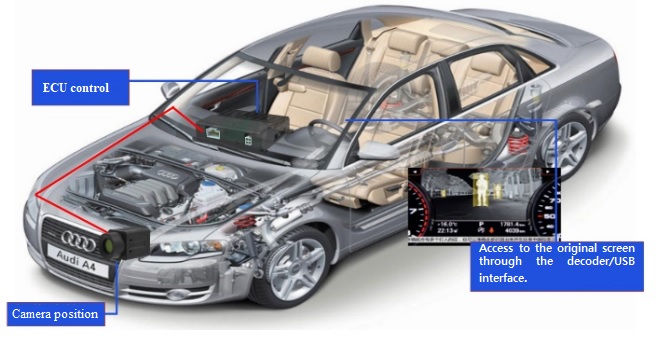Enhance Your Night Driving with a Thermal Camera Night Vision System

Introduction
Night driving can be a challenging and potentially dangerous activity. Reduced visibility, glare from oncoming headlights, and the difficulty of spotting pedestrians or obstacles in the dark can all contribute to accidents on the road. That's why it's crucial to prioritize safety and take advantage of advanced driving assistance products like the Car Thermal Imager Night Vision System.
This innovative system utilizes thermal imaging technology to enhance night driving safety by providing drivers with improved visibility and early warning of potential hazards. By detecting heat signatures emitted by objects, the thermal camera can accurately identify pedestrians and cars even in complete darkness or adverse weather conditions.
With easy installation and a wide range of features, this system is designed to make night driving safer and more comfortable. The Car Thermal Imager Night Vision System offers long-distance vision, allowing drivers to see far ahead and anticipate any potential dangers on the road. Its anti-glare capability ensures that bright lights from other vehicles won't blind the driver, further enhancing safety.
In addition to its enhanced visibility features, this system also comes with collision warning functionality. It can detect potential collisions with objects or vehicles ahead and provide early warnings to the driver, giving them precious seconds to react and avoid accidents. This feature alone can significantly reduce the risk of accidents during nighttime driving.
To ensure proper functionality, it is important to have the Car Thermal Imager Night Vision System installed by professionals. This will guarantee that all components are correctly set up and calibrated for optimal performance. Additionally, proper usage precautions should be followed to maximize safety benefits.
As technology continues to advance, we can expect even more exciting developments in thermal imaging technology for automotive safety. The future holds great promise for integrating thermal cameras into various aspects of vehicle design and functionality. From pedestrian detection systems to adaptive cruise control, thermal imaging has the potential to revolutionize how we drive at night.
Features and Benefits of the Thermal Camera Night Vision System
The Car Thermal Imager Night Vision System is a cutting-edge driving assistance product that utilizes thermal imaging technology to significantly improve night driving safety. By providing enhanced visibility and early warning of potential hazards, this system offers numerous features and benefits that are crucial for drivers seeking a safer nighttime driving experience.
Enhanced visibility and safety during night driving
One of the key advantages of the Car Thermal Imager Night Vision System is its ability to enhance visibility during nighttime driving conditions. Traditional headlights can only illuminate a limited area directly in front of the vehicle, making it difficult to detect pedestrians, animals, or other obstacles that may be lurking in the darkness. However, with the integration of thermal imaging technology, this system allows drivers to see beyond the scope of traditional headlights.
Thermal imaging works by detecting heat signatures emitted by objects and converting them into visible images on a display screen. Unlike traditional cameras that rely on visible light, thermal cameras can capture images even in complete darkness or adverse weather conditions such as fog or rain. This means that even if an object is not within the range of the vehicle's headlights, it can still be detected by the thermal camera.
The benefits of enhanced visibility are significant when it comes to night driving safety. By being able to see beyond what traditional headlights illuminate, drivers using the Car Thermal Imager Night Vision System have a greater chance of detecting potential hazards well in advance. This includes pedestrians crossing the road, animals darting across their path, or even vehicles merging from blind spots.
Furthermore, this system provides an additional layer of safety by alerting drivers to potential dangers through collision warnings. The thermal camera can accurately identify objects in real-time and provide visual or audible alerts if there is a risk of collision. This early warning system gives drivers crucial seconds to react and take evasive action, potentially preventing accidents and saving lives.
The role of thermal imaging technology in driving assistance
Thermal imaging technology plays a vital role in driving assistance systems, such as the Car Thermal Imager Night Vision System. By harnessing the power of thermal cameras, these systems can provide valuable information to drivers and help them make better decisions on the road.
Thermal imaging works by capturing the heat signatures emitted by objects and converting them into visual representations. This allows drivers to see beyond what is visible to the naked eye, enabling them to detect potential hazards that may not be apparent through traditional means.
One of the key advantages of thermal imaging technology is its ability to differentiate between objects based on their temperature differences. This means that even in complete darkness or low-visibility conditions, thermal cameras can accurately identify pedestrians, animals, and other vehicles based on their heat signatures. This level of accuracy is crucial for ensuring driver safety and preventing accidents.
Additionally, thermal imaging technology can help drivers navigate challenging weather conditions. Traditional headlights can be rendered ineffective in heavy fog or rain, reducing visibility and increasing the risk of accidents. However, thermal cameras are unaffected by these adverse weather conditions since they rely on detecting heat rather than visible light. This allows drivers using a thermal camera night vision system to maintain visibility even in inclement weather.
Furthermore, thermal imaging technology can also assist in identifying potential mechanical issues with the vehicle itself. By detecting abnormal heat patterns or hotspots within the engine or other components, drivers can be alerted to possible malfunctions before they escalate into more significant problems. This proactive approach to vehicle maintenance not only enhances safety but also helps prevent costly repairs down the line.
Proper Installation and Usage Precautions
When it comes to ensuring the optimal performance and functionality of the Car Thermal Imager Night Vision System, proper installation and usage precautions are of utmost importance. In this section, we will delve into the significance of professional installation and provide instructions on how to use the system correctly.
Importance of Professional Installation
To guarantee that the Car Thermal Imager Night Vision System operates at its full potential, it is highly recommended to have it installed by professionals. While some car owners may be tempted to install the system themselves, there are several reasons why professional installation is essential.
Firstly, professionals have the expertise and experience necessary to handle the intricacies of installing a thermal camera night vision system. They are familiar with the specific requirements of different car models, ensuring that the installation process is carried out accurately and efficiently.
Secondly, professional installers possess specialized tools that enable them to securely mount and connect the thermal camera system. This ensures that all components are properly aligned and connected, minimizing any potential issues or malfunctions down the line.
Moreover, professional installation guarantees that all wiring connections are secure and protected from damage. This is particularly crucial as improper wiring can lead to electrical shorts or even pose a fire hazard. By entrusting the installation process to professionals, car owners can have peace of mind knowing that their safety is prioritized.
Usage Precautions for the Car Thermal Imager Night Vision System
Once properly installed, it is important for users to be aware of certain precautions in order to optimize their experience with the Car Thermal Imager Night Vision System. By following these guidelines, drivers can ensure both their own safety and longevity of the system.
Firstly, it is vital to regularly clean and maintain the thermal camera lens. Accumulation of dirt or debris on the lens can obstruct visibility and compromise image quality. To clean the lens, use a soft microfiber cloth or lens cleaning solution specifically designed for camera lenses. Avoid using abrasive materials or harsh chemicals that could potentially damage the lens coating.
Additionally, it is recommended to avoid touching the thermal camera lens with bare hands. The oils and residues on our skin can leave smudges or fingerprints on the lens, affecting image clarity. If accidental contact occurs, clean the lens immediately using the aforementioned cleaning methods.
Furthermore, it is crucial to protect the Car Thermal Imager Night Vision System from extreme temperatures and moisture. While the system is designed to withstand a wide temperature range from -40℃ to 70℃, exposing it to temperatures beyond this range may lead to performance issues or irreversible damage. Similarly, ensure that all connections and ports are properly sealed to prevent water ingress, as water damage can impair the functionality of the system.
Lastly, familiarize yourself with the system's user manual and follow all instructions provided by the manufacturer. This includes understanding how to adjust settings such as brightness and contrast for optimal visibility in various driving conditions. Additionally, be mindful of any specific maintenance recommendations outlined in the manual.
By adhering to these installation and usage precautions, car owners can fully enjoy the benefits of their Car Thermal Imager Night Vision System while ensuring its longevity and reliability. Remember, safety should always be a top priority when it comes to driving assistance products like this one.
The Future of Thermal Imaging Technology in Automotive Safety
Advancements in thermal imaging technology have paved the way for exciting possibilities in automotive safety. As the demand for enhanced driving assistance systems continues to grow, researchers and engineers are constantly exploring new ways to leverage thermal imaging technology to improve road safety.
One of the key areas of development is the integration of artificial intelligence (AI) algorithms with thermal cameras. By combining AI capabilities with thermal imaging, vehicles will be able to detect and interpret complex scenarios on the road more accurately. This can include identifying pedestrians, cyclists, and animals even in challenging lighting conditions or low visibility situations.
Another area of focus is the miniaturization of thermal cameras. As technology becomes more compact and affordable, it is expected that thermal cameras will become a standard feature in vehicles, similar to other safety systems like rearview cameras or lane departure warning systems. This widespread adoption will further enhance night driving safety by providing drivers with real-time information about potential hazards on the road.
Furthermore, advancements in image processing algorithms are also contributing to the future of thermal imaging technology in automotive safety. These algorithms help improve image quality, reduce noise, and enhance object recognition capabilities. With these advancements, drivers can expect even clearer and more accurate images from their thermal camera night vision systems.
In conclusion, the future of automotive safety looks promising with ongoing advancements in thermal imaging technology. The integration of AI algorithms, miniaturization of thermal cameras, and improvements in image processing will revolutionize how we perceive night driving. With enhanced visibility and early warning systems provided by thermal camera night vision systems, drivers can confidently navigate roads at night while minimizing risks and ensuring their own safety as well as that of others on the road.
See Also
Improve Your Driving Experience with a Thermal Imaging Camera for Land Rover Doctor
Boost Nighttime Driving Safety with Automotive Thermal Imaging for Land Rover Jaguar
Tăng cường trải nghiệm lái xe của bạn với Camera hình ảnh nhiệt cho Land Rover Doctor
Aprimore a sua experiência de condução com uma câmera de imagem térmica para Land Rover Doctor
Eleve a segurança ao dirigir à noite com imagens térmicas automotivas para Land Rover Jaguar
Contact Us: Ms. Coco Huang
E-mail: sales@iasun.cn
WhatsApp/Wechat: +86 13510421923


